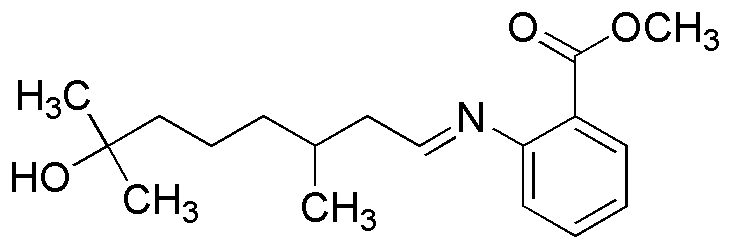Methyl N-(3,7-Dimethyl-7-Hydroxyoctylidene)-anthranilate is widely utilized in research focused on:
- Cosmetic Formulations: This compound is often used in skincare products for its UV-filtering properties, helping to protect the skin from harmful sun rays while providing a moisturizing effect.
- Pharmaceutical Applications: It serves as an ingredient in various medicinal formulations, particularly in topical treatments aimed at reducing inflammation and providing relief from skin irritations.
- Fragrance Industry: The compound is employed in the production of fragrances due to its pleasant scent profile, enhancing the olfactory appeal of perfumes and scented products.
- Food Industry: It can be used as a flavoring agent or preservative in food products, contributing to taste enhancement while also offering antioxidant properties.
- Research and Development: In scientific studies, it is used as a model compound to explore the interactions of similar chemical structures, aiding in the development of new materials and formulations.
General Information
Properties
Safety and Regulations
Applications
Methyl N-(3,7-Dimethyl-7-Hydroxyoctylidene)-anthranilate is widely utilized in research focused on:
- Cosmetic Formulations: This compound is often used in skincare products for its UV-filtering properties, helping to protect the skin from harmful sun rays while providing a moisturizing effect.
- Pharmaceutical Applications: It serves as an ingredient in various medicinal formulations, particularly in topical treatments aimed at reducing inflammation and providing relief from skin irritations.
- Fragrance Industry: The compound is employed in the production of fragrances due to its pleasant scent profile, enhancing the olfactory appeal of perfumes and scented products.
- Food Industry: It can be used as a flavoring agent or preservative in food products, contributing to taste enhancement while also offering antioxidant properties.
- Research and Development: In scientific studies, it is used as a model compound to explore the interactions of similar chemical structures, aiding in the development of new materials and formulations.
Documents
Safety Data Sheets (SDS)
The SDS provides comprehensive safety information on handling, storage, and disposal of the product.
Product Specification (PS)
The PS provides a comprehensive breakdown of the product’s properties, including chemical composition, physical state, purity, and storage requirements. It also details acceptable quality ranges and the product's intended applications.
Certificates of Analysis (COA)
Search for Certificates of Analysis (COA) by entering the products Lot Number. Lot and Batch Numbers can be found on a product’s label following the words ‘Lot’ or ‘Batch’.
*Catalog Number
*Lot Number
Certificates Of Origin (COO)
This COO confirms the country where the product was manufactured, and also details the materials and components used in it and whether it is derived from natural, synthetic, or other specific sources. This certificate may be required for customs, trade, and regulatory compliance.
*Catalog Number
*Lot Number
Safety Data Sheets (SDS)
The SDS provides comprehensive safety information on handling, storage, and disposal of the product.
DownloadProduct Specification (PS)
The PS provides a comprehensive breakdown of the product’s properties, including chemical composition, physical state, purity, and storage requirements. It also details acceptable quality ranges and the product's intended applications.
DownloadCertificates of Analysis (COA)
Search for Certificates of Analysis (COA) by entering the products Lot Number. Lot and Batch Numbers can be found on a product’s label following the words ‘Lot’ or ‘Batch’.
*Catalog Number
*Lot Number
Certificates Of Origin (COO)
This COO confirms the country where the product was manufactured, and also details the materials and components used in it and whether it is derived from natural, synthetic, or other specific sources. This certificate may be required for customs, trade, and regulatory compliance.

